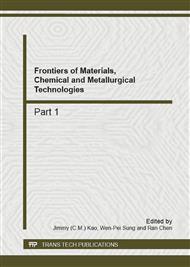p.851
p.856
p.861
p.868
p.873
p.879
p.883
p.888
p.895
Microwave Digestion-ICP-MS Determination of Vanadium Oxide for 22 Impurity Elements
Abstract:
With the utilization of hydrofluoric acid and nitric acid, vanadium oxide samples such as V2O5 and V2O3 are digested by the way of high-pressure closed microwave heating and 22 impurity elements with concentration of 0.0001% ~ 0.5% including Nb, Zr, Ti, W, Si, Al, Mo, Co, Cr, Ni, Cu, Pb, Cd, As, P, Fe, Mn, Ca, Mg, Na, K and B are directly and simultaneously determined by inductively coupled plasma mass spectrometry (ICP-MS). The optimum microwave digestion conditions, combination and ratio of the digestion reagents, optimization of detection conditions, matrix effects, mass interferences and other influencing factors are investigated; in order to eliminate the mass spectrum interference from vanadium matrix isobars and polyatomic ion formed by combination of these isobars and Ar, O, H and other atoms, isotopes of the test elements with high abundance sensitivity and little interference are selected for analysis of elements; the analyte is divided into two mass regions, respectively using Sc and Rh as internal standard for the correction of matrix effects. The results show that: V2O5, V2O3 and impurities contained in the matrix can be quickly and completely digested, thus, insoluble oxides or volatile impurities such as Nb, Zr, Ti, W, Si, Al, Cr and As can be digested without a loss; the stability and precision of continuous determination is significantly improved by Sc and Rh internal standard correction method, and matrix effects, interface effects and other effects generated in high vanadium-based matrix are effectively eliminated. The test also boosts a detection limit of 0.01 ~ 0.89μg /L, correlation coefficient r ≥ 0.9991, recovery rate of 90% ~ 113% and RSD <5%. This method can meet the need to simultaneously determine 22 kinds of micro, trace and ultra-trace impurities of various normal or high-purity V2O5, V2O3 and other vanadium oxides.
Info:
Periodical:
Pages:
873-878
Citation:
Online since:
October 2012
Authors:
Price:
Сopyright:
© 2012 Trans Tech Publications Ltd. All Rights Reserved
Share:
Citation:


